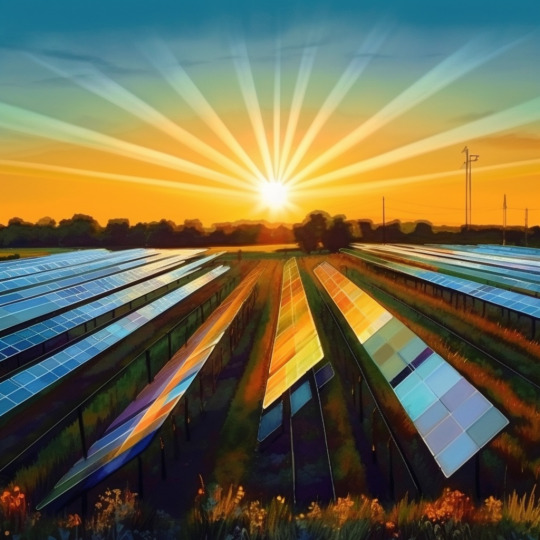#AI In The Renewable Energy
Explore tagged Tumblr posts
Text
Uncover AI Solutions For Sustainable Energy. See How AI Enhances Renewable Resource Use, Lowers Carbon Emissions, And Promotes Global Sustainability.
#AI In The Renewable Energy#AI-Based Predictive Data Analysis#AI-Driven Predictive Analytics#Artificial Intelligence Development#Predict Energy Consumption Trends#Predictive MAIntenance#Renewable Energy Consumptions#SustAInable Energy Planning#Systematic Data Analysis#Use Of AI Applications
0 notes
Text
Real innovation vs Silicon Valley nonsense

This is the LAST DAY to get my bestselling solarpunk utopian novel THE LOST CAUSE (2023) as a $2.99, DRM-free ebook!

If there was any area where we needed a lot of "innovation," it's in climate tech. We've already blown through numerous points-of-no-return for a habitable Earth, and the pace is accelerating.
Silicon Valley claims to be the epicenter of American innovation, but what passes for innovation in Silicon Valley is some combination of nonsense, climate-wrecking tech, and climate-wrecking nonsense tech. Forget Jeff Hammerbacher's lament about "the best minds of my generation thinking about how to make people click ads." Today's best-paid, best-trained technologists are enlisted to making boobytrapped IoT gadgets:
https://pluralistic.net/2024/05/24/record-scratch/#autoenshittification
Planet-destroying cryptocurrency scams:
https://pluralistic.net/2024/02/15/your-new-first-name/#that-dagger-tho
NFT frauds:
https://pluralistic.net/2022/02/06/crypto-copyright-%f0%9f%a4%a1%f0%9f%92%a9/
Or planet-destroying AI frauds:
https://pluralistic.net/2024/01/29/pay-no-attention/#to-the-little-man-behind-the-curtain
If that was the best "innovation" the human race had to offer, we'd be fucking doomed.
But – as Ryan Cooper writes for The American Prospect – there's a far more dynamic, consequential, useful and exciting innovation revolution underway, thanks to muscular public spending on climate tech:
https://prospect.org/environment/2024-05-30-green-energy-revolution-real-innovation/
The green energy revolution – funded by the Bipartisan Infrastructure Act, the Inflation Reduction Act, the CHIPS Act and the Science Act – is accomplishing amazing feats, which are barely registering amid the clamor of AI nonsense and other hype. I did an interview a while ago about my climate novel The Lost Cause and the interviewer wanted to know what role AI would play in resolving the climate emergency. I was momentarily speechless, then I said, "Well, I guess maybe all the energy used to train and operate models could make it much worse? What role do you think it could play?" The interviewer had no answer.
Here's brief tour of the revolution:
2023 saw 32GW of new solar energy come online in the USA (up 50% from 2022);
Wind increased from 118GW to 141GW;
Grid-scale batteries doubled in 2023 and will double again in 2024;
EV sales increased from 20,000 to 90,000/month.
https://www.whitehouse.gov/briefing-room/blog/2023/12/19/building-a-thriving-clean-energy-economy-in-2023-and-beyond/
The cost of clean energy is plummeting, and that's triggering other areas of innovation, like using "hot rocks" to replace fossil fuel heat (25% of overall US energy consumption):
https://rondo.com/products
Increasing our access to cheap, clean energy will require a lot of materials, and material production is very carbon intensive. Luckily, the existing supply of cheap, clean energy is fueling "green steel" production experiments:
https://www.wdam.com/2024/03/25/americas-1st-green-steel-plant-coming-perry-county-1b-federal-investment/
Cheap, clean energy also makes it possible to recover valuable minerals from aluminum production tailings, a process that doubles as site-remediation:
https://interestingengineering.com/innovation/toxic-red-mud-co2-free-iron
And while all this electrification is going to require grid upgrades, there's lots we can do with our existing grid, like power-line automation that increases capacity by 40%:
https://www.npr.org/2023/08/13/1187620367/power-grid-enhancing-technologies-climate-change
It's also going to require a lot of storage, which is why it's so exciting that we're figuring out how to turn decommissioned mines into giant batteries. During the day, excess renewable energy is channeled into raising rock-laden platforms to the top of the mine-shafts, and at night, these unspool, releasing energy that's fed into the high-availability power-lines that are already present at every mine-site:
https://www.euronews.com/green/2024/02/06/this-disused-mine-in-finland-is-being-turned-into-a-gravity-battery-to-store-renewable-ene
Why are we paying so much attention to Silicon Valley pump-and-dumps and ignoring all this incredible, potentially planet-saving, real innovation? Cooper cites a plausible explanation from the Apperceptive newsletter:
https://buttondown.email/apperceptive/archive/destructive-investing-and-the-siren-song-of/
Silicon Valley is the land of low-capital, low-labor growth. Software development requires fewer people than infrastructure and hard goods manufacturing, both to get started and to run as an ongoing operation. Silicon Valley is the place where you get rich without creating jobs. It's run by investors who hate the idea of paying people. That's why AI is so exciting for Silicon Valley types: it lets them fantasize about making humans obsolete. A company without employees is a company without labor issues, without messy co-determination fights, without any moral consideration for others. It's the natural progression for an industry that started by misclassifying the workers in its buildings as "contractors," and then graduated to pretending that millions of workers were actually "independent small businesses."
It's also the natural next step for an industry that hates workers so much that it will pretend that their work is being done by robots, and then outsource the labor itself to distant Indian call-centers (no wonder Indian techies joke that "AI" stands for "absent Indians"):
https://pluralistic.net/2024/05/17/fake-it-until-you-dont-make-it/#twenty-one-seconds
Contrast this with climate tech: this is a profoundly physical kind of technology. It is labor intensive. It is skilled. The workers who perform it have power, both because they are so far from their employers' direct oversight and because these fed-funded sectors are more likely to be unionized than Silicon Valley shops. Moreover, climate tech is capital intensive. All of those workers are out there moving stuff around: solar panels, wires, batteries.
Climate tech is infrastructural. As Deb Chachra writes in her must-read 2023 book How Infrastructure Works, infrastructure is a gift we give to our descendants. Infrastructure projects rarely pay for themselves during the lives of the people who decide to build them:
https://pluralistic.net/2023/10/17/care-work/#charismatic-megaprojects
Climate tech also produces gigantic, diffused, uncapturable benefits. The "social cost of carbon" is a measure that seeks to capture how much we all pay as polluters despoil our shared world. It includes the direct health impacts of burning fossil fuels, and the indirect costs of wildfires and extreme weather events. The "social savings" of climate tech are massive:
https://arstechnica.com/science/2024/05/climate-and-health-benefits-of-wind-and-solar-dwarf-all-subsidies/
For every MWh of renewable power produced, we save $100 in social carbon costs. That's $100 worth of people not sickening and dying from pollution, $100 worth of homes and habitats not burning down or disappearing under floodwaters. All told, US renewables have delivered $250,000,000,000 (one quarter of one trillion dollars) in social carbon savings over the past four years:
https://arstechnica.com/science/2024/05/climate-and-health-benefits-of-wind-and-solar-dwarf-all-subsidies/
In other words, climate tech is unselfish tech. It's a gift to the future and to the broad public. It shares its spoils with workers. It requires public action. By contrast, Silicon Valley is greedy tech that is relentlessly focused on the shortest-term returns that can be extracted with the least share going to labor. It also requires massive public investment, but it also totally committed to giving as little back to the public as is possible.
No wonder America's richest and most powerful people are lining up to endorse and fund Trump:
https://prospect.org/blogs-and-newsletters/tap/2024-05-30-democracy-deshmocracy-mega-financiers-flocking-to-trump/
Silicon Valley epitomizes Stafford Beer's motto that "the purpose of a system is what it does." If Silicon Valley produces nothing but planet-wrecking nonsense, grifty scams, and planet-wrecking, nonsensical scams, then these are all features of the tech sector, not bugs.
As Anil Dash writes:
Driving change requires us to make the machine want something else. If the purpose of a system is what it does, and we don’t like what it does, then we have to change the system.
https://www.anildash.com/2024/05/29/systems-the-purpose-of-a-system/
To give climate tech the attention, excitement, and political will it deserves, we need to recalibrate our understanding of the world. We need to have object permanence. We need to remember just how few people were actually using cryptocurrency during the bubble and apply that understanding to AI hype. Only 2% of Britons surveyed in a recent study use AI tools:
https://www.bbc.com/news/articles/c511x4g7x7jo
If we want our tech companies to do good, we have to understand that their ground state is to create planet-wrecking nonsense, grifty scams, and planet-wrecking, nonsensical scams. We need to make these companies small enough to fail, small enough to jail, and small enough to care:
https://pluralistic.net/2024/04/04/teach-me-how-to-shruggie/#kagi
We need to hold companies responsible, and we need to change the microeconomics of the board room, to make it easier for tech workers who want to do good to shout down the scammers, nonsense-peddlers and grifters:
https://pluralistic.net/2023/07/28/microincentives-and-enshittification/
Yesterday, a federal judge ruled that the FTC could hold Amazon executives personally liable for the decision to trick people into signing up for Prime, and for making the unsubscribe-from-Prime process into a Kafka-as-a-service nightmare:
https://arstechnica.com/tech-policy/2024/05/amazon-execs-may-be-personally-liable-for-tricking-users-into-prime-sign-ups/
Imagine how powerful a precedent this could set. The Amazon employees who vociferously objected to their bosses' decision to make Prime as confusing as possible could have raised the objection that doing this could end up personally costing those bosses millions of dollars in fines:
https://pluralistic.net/2023/09/03/big-tech-cant-stop-telling-on-itself/
We need to make climate tech, not Big Tech, the center of our scrutiny and will. The climate emergency is so terrifying as to be nearly unponderable. Science fiction writers are increasingly being called upon to try to frame this incomprehensible risk in human terms. SF writer (and biologist) Peter Watts's conversation with evolutionary biologist Dan Brooks is an eye-opener:
https://thereader.mitpress.mit.edu/the-collapse-is-coming-will-humanity-adapt/
They draw a distinction between "sustainability" meaning "what kind of technological fixes can we come up with that will allow us to continue to do business as usual without paying a penalty for it?" and sustainability meaning, "what changes in behavior will allow us to save ourselves with the technology that is possible?"
Writing about the Watts/Brooks dialog for Naked Capitalism, Yves Smith invokes William Gibson's The Peripheral:
With everything stumbling deeper into a ditch of shit, history itself become a slaughterhouse, science had started popping. Not all at once, no one big heroic thing, but there were cleaner, cheaper energy sources, more effective ways to get carbon out of the air, new drugs that did what antibiotics had done before…. Ways to print food that required much less in the way of actual food to begin with. So everything, however deeply fucked in general, was lit increasingly by the new, by things that made people blink and sit up, but then the rest of it would just go on, deeper into the ditch. A progress accompanied by constant violence, he said, by sufferings unimaginable.
https://www.nakedcapitalism.com/2024/05/preparing-for-collapse-why-the-focus-on-climate-energy-sustainability-is-destructive.html
Gibson doesn't think this is likely, mind, and even if it's attainable, it will come amidst "unimaginable suffering."
But the universe of possible technologies is quite large. As Chachra points out in How Infrastructure Works, we could give every person on Earth a Canadian's energy budget (like an American's, but colder), by capturing a mere 0.4% of the solar radiation that reaches the Earth's surface every day. Doing this will require heroic amounts of material and labor, especially if we're going to do it without destroying the planet through material extraction and manufacturing.
These are the questions that we should be concerning ourselves with: what behavioral changes will allow us to realize cheap, abundant, green energy? What "innovations" will our society need to focus on the things we need, rather than the scams and nonsense that creates Silicon Valley fortunes?
How can we use planning, and solidarity, and codetermination to usher in the kind of tech that makes it possible for us to get through the climate bottleneck with as little death and destruction as possible? How can we use enforcement, discernment, and labor rights to thwart the enshittificatory impulses of Silicon Valley's biggest assholes?

If you'd like an essay-formatted version of this post to read or share, here's a link to it on pluralistic.net, my surveillance-free, ad-free, tracker-free blog:
https://pluralistic.net/2024/05/30/posiwid/#social-cost-of-carbon
#pluralistic#ai#hype#anil dash#stafford beer#amazon#prime#scams#dark patterns#POSIWID#the purpose of a system is what it does#climate#economics#innovation#renewables#social cost of carbon#green energy#solar#wind#ryan cooper#peter watts#the jackpot#ai hype#chips act#ira#inflation reduction act#infrastructure#deb chachra
157 notes
·
View notes
Photo



Envision Our Energizing-Vibrant Renewable Future Now
#earth day#earth month#renewable energy#renewable power#ai art#ai#image generation#design#climate art#renewable electricity#power sources#vibrant skies#solar power#solar#wind#wind energy#green future#solarpunk#renewables#midjourney#imagination#image building
253 notes
·
View notes
Text

#Doge#Federal Agencies#Legislative Process#U.S. Constitution#Supreme Court Decisions#Congress#National Security#Civil Rights#Economic Policy#Public Policy#SpaceX#Tesla#Neuralink#Starlink#Renewable Energy#AI Development#Innovation#Twitter (X)#elon musk#us government#donald trump#us elections#britishblogger#today on tumblr#new blog#tucker carlson#politics#vivek ramaswamy#Department of Government Efficiency
5 notes
·
View notes
Text
Technology's Use of Water
While water is renewable, it is finite. Its renewability depends on us using and managing our water resources responsibly.
Previous articles on this page have discussed hydropower and how it produces less waste and costs less than other resources. We have also briefly discussed how other energy sources consume water as a coolant or receptacle for waste. Entire university courses are dedicated to human uses of water.
Water Scarcity
Only 3% of water on Earth is freshwater. Of course, we need this to drink, but we need it for many more services beyond that.
Many plumbing fixtures are made of copper, which saltwater severely corrodes, same as lead and, over a longer time, PVC. Toilets on average use 1-5 gallons of water per flush. If we want to preserve freshwater by switching to saltwater plumbing, we would have to rethink and re-pipe entire plumbing systems.
We lose safe water in rain, as well. Supported by a study in Environmental Science and Technology, the Center for Disease Control and Prevention in 2022 stated that rainwater is not safe to drink. Chemicals known as per-/poly-fluoroalkyl substances break down extremely slowly, and have leached from many products like cleaners, fabrics, and shampoo into the water cycle. Removing PFAS from water requires filters of activated carbon or reverse osmosis membranes, which also require frequent maintenance.
A lot of water is also not available to us because it is in ice caps and glaciers, which are estimated to be about 68% of Earth’s freshwater. This water is also being lost, because as glaciers melt at increasing rates, that freshwater becomes saltwater in the ocean.
These limitations mean that water is not necessarily renewable yet, especially because treating water produces its own waste and pollution. We have to be responsible with the small percentage of water we have access to.
Irresponsible Use
There are a ridiculous amount of ways in which we waste water. Leaks, watering lawns, and leaving taps running are some of the big household wastes of water. While individual accountability and changes can still make a big difference, I want to focus on bigger impacts.
One example is in nuclear power production. Nuclear power plants use water to cool down used fuel when it is done being used in the reactor. This results in radioactive and thermal water pollution.
Agriculture is another common cause of water pollution. Excess water from rain or artificial watering runs off of agricultural fields and flows towards streams and bodies of water. This runoff often includes amounts of fertilizers and pesticides ranging from minimal to extremely harmful. This leads to improper levels of oxygen, nitrogen, and hydrogen within the water. Like water contaminated by pharmaceuticals, this is not safe to drink, and something not safe for skin contact.
Technology is also a major factor of water demands. Artificial Intelligence and cryptocurrency are heavy water consumers.
AI is beneficial within waste management, as it is able to quickly analyze information and identify issues, potential problems, and potential areas of improvement. Unfortunately, AI training requires a large amount of water. One study states that training GPT-3 alone can evaporate 700,000 liters of freshwater. In 2027, AI is predicted to consume 4.2 to 6.6 billion cubic meters of water. In comparison, Denmark nationally consumes around one billion cubic meters in a year.
Cryptocurrency is even worse. It goes through a process called mining in which transactions are verified and new ‘coins’ are generated into the system. This process is extremely water-demanding. For example, in 2021, mining of Bitcoin consumed more than 1,600 gigaliters of global water. On average, each cryptocurrency transaction consumes 16,000 liters of water in cooling down the computer equipment and the power plants that provide the electricity.
Saltwater as an alternative in these situations does exist; however, this process has the disadvantages of one-time use, large water intake, sewage discharge, and ocean pollution. Technology has begun to improve on this method with seawater circulation cooling technology, which reduces sewage discharge and water intake, but remains an imperfect solution.
Technology has the potential to drastically improve environmental management and restoration, but still has a long way to go before we offset the huge impacts we have made. Freshwater is taken for granted by many people, and the systems that disproportionately consume the most of it are not held accountable. This cycle must stop if we want to make water a truly renewable resource.
Additional Resources
1. Water Renewability
2. Corrosion on Plumbing
3. Treating PFAS
4. Household Water Waste
5. Nuclear Water Waste
6. AI Helping Water Management
7. AI Water Consumption
8. Crypto Mining Water Consumption
9. Seawater cooling technology
#renewable power#renewable energy#water#water pollution#technology#artificial intelligence#ai training#cryptocurrency#digital currency#bitcoin#article#research#resources#environment#climate change#science
4 notes
·
View notes
Text
#1. Global Politics#“2024 US Election”#“Russia Ukraine conflict”#“China Taiwan tensions”#“Israel Palestine ceasefire”#“NATO expansion”#2. Technology & Innovation#“AI advancements”#“Quantum computing breakthroughs”#“ChatGPT updates”#“5G technology”#“Electric vehicles news”#3. Climate & Environment#“Climate change summit”#“Carbon capture technology”#“Wildfires 2024”#“Renewable energy news”#“Green energy investments”#4. Business & Economy#“Stock market news”#“Global inflation rates”#“Cryptocurrency market trends”#“Tech IPOs 2024”#“Supply chain disruptions”#5. Health & Wellness#“COVID-19 variants”#“Mental health awareness”#“Vaccine development”#“Obesity treatment breakthroughs”#“Telemedicine growth”
2 notes
·
View notes
Text
The AI Power Conundrum: Will Renewables Save the Day?
The rapid advancement of artificial intelligence (AI) technologies is transforming industries and driving unprecedented innovation. However, the surge in AI applications comes with a significant challenge: the growing power demands required to sustain these systems. As we embrace the era of AI power, the question arises: can renewable energy rise to meet these increasing energy needs?
Understanding the AI Power Demand
AI systems, particularly those involving deep learning and large-scale data processing, consume vast amounts of electricity. Data centers housing AI servers are notorious for their high energy requirements, often leading to increased carbon emissions. As AI continues to evolve, the demand for energy is expected to skyrocket, posing a substantial challenge for sustainability.
The Role of Renewable Energy
Renewable energy sources, such as solar, wind, and hydroelectric power, present a viable solution to the AI power conundrum. These sources produce clean, sustainable energy that can help offset the environmental impact of AI technologies. By harnessing renewable energy, tech companies can significantly reduce their carbon footprint while meeting their power needs.
Tech Giants Leading the Way
Several tech giants are already paving the way by integrating renewable energy into their operations. Companies like Google, Amazon, and Microsoft are investing heavily in renewable energy projects to power their data centers. For instance, Google has committed to operating on 24/7 carbon-free energy by 2030. These initiatives demonstrate the potential for renewable energy to support the massive energy demands of AI power.
Challenges and Opportunities
While the integration of renewable energy is promising, it comes with its own set of challenges. Renewable energy sources can be intermittent, depending on weather conditions, which can affect their reliability. However, advancements in energy storage solutions and smart grid technologies are addressing these issues, ensuring a more stable and dependable supply of renewable energy.
The synergy between AI and renewable energy also presents unique opportunities. AI can optimize the performance of renewable energy systems, predict energy demand, and enhance energy efficiency. This symbiotic relationship has the potential to accelerate the adoption of renewable energy and create a more sustainable future.
Conclusion
The AI power conundrum is a pressing issue that demands innovative solutions. Renewable energy emerges as a crucial player in addressing this challenge, offering a sustainable path forward. As tech companies continue to embrace renewable energy, the future of AI power looks promising, with the potential to achieve both technological advancement and environmental sustainability.
By integrating renewable energy into the AI ecosystem, we can ensure that the growth of AI technologies does not come at the expense of our planet. The collaboration between AI and renewable energy is not just a possibility; it is a necessity for a sustainable future.
2 notes
·
View notes
Text

2 notes
·
View notes
Text
Daily writing promptThe most important invention in your lifetime is…View all responses Picking the “most important” invention is like choosing a favourite child … almost impossible and totally subjective! But between 1969’s moon landing and today’s AI marvels, some contenders deserve a shoutout, in my opinion: The Internet (1969): Launched as a whisper on October 29, 1969, when computers at…

View On WordPress
#AI#Artificial Intelligence#dailyprompt#dailyprompt-1840#Digital Knowledge Sharing#Internet#Invention#knowledge#Massive Open Online Courses#MOOC#Personal Computers#Raffaello Palandri#Renewable Energy#Technology
2 notes
·
View notes
Text
A Look Inside Elon Musk's Rygar Enterprises
Learn about Elon Musk's Rygar Enterprises, its history, projects, and plans for the future of technology. Discover about rygar enterprises.
Introduction: Who hasn’t heard of Elon Musk? His name is practically inseparable from concepts such as innovation, ambition, and an unyielding pursuit of progress. This titan of the industry has a long and storied career, from his founding of PayPal to his more recent ventures like Tesla, SpaceX, and The Boring Company. But now, he’s made yet another move that’s sure to shake things up: the…

View On WordPress
#A Look Inside Elon Musk&039;s Rygar Enterprises#AI research#artificial intelligence#brain-computer interface#creativity#disruption#electric cars#Elon Musk#engineering#entrepreneurship#future of transportation#Hyperloop#innovation#leadership#Mars colonization#Mars mission#Neuralink#OpenAI#renewable energy#Rygar Enterprises#SolarCity#space exploration#SpaceX#SpaceX Starship#sustainable living#technology#Tesla#The Boring Company#tunnel construction#vision
7 notes
·
View notes
Text
hiya! so I just woke up and my brain is still booting up but I'm very tired of seeing this "AI specifically is killing the planet and ruining everything" argument bc it simply is not true! you do not have to like AI but misinformation is still wrong to spread even if it supports your viewpoint, yeah?
it costs less energy than rendering an image in blender. training AI does take a lot of energy, but generation not so much, and because generation is so cheap it ends up paying for itself.
here's an article about how carbon emissions are lower for AI writing + image generation than having a human sit at a computer and make those same things.
here's an analysis of AI and data center energy consumption, too.
this redditor crunched the numbers pretty well:

+ wrt water usage, water used in data centers are typically closed systems. what isn't used evaporates and then condensates back into the system. there is some loss here but that doesn't mean water is destroyed, it means it is returned to the environment instead. water cycle baybee! I've heard some people complaining that data centers are why there's not enough water to help the cali fires but it's actually due to agricultural mismanagement.
again everyone's free to feel as they do about AI usage, but I do find it odd that this is the point people keep coming back to bc it's not true + there are other things most people do daily that are damaging the planet considerably more. how much energy do you think it cost to get your food to you for example? do you drive to work?
the wealthy consume energy far more frivolously than you or I, and sometimes this shit kind of feels like a psyop to keep us divided and angry at each other for small things like this vs angry with the oligarchy running our lives. it feels so misguided and short sighted.
AI isn't going to just stop existing, the cat has been out of the bag for way too long. we literally cannot go back even if you want to. the ai wars are pointless to fight bc we've already lost them to the ai, imo this discourse feels like beating a dead horse
Idgaf if you don't want to write essays for school. I don't care if you don't want to write corporate emails yourself. I don't care if you can't draw well, I don't care if you can't write well, I don't care if you just really really want to talk to your favorite fictional character but don't want to RP with a real person because you have social anxiety or whatever
If you're still regularly using generative ai, chatgpt or midjourney or character.ai or literally whatever the fuck, im personally blaming you when my utility prices start going up.
#not to mention the ways AI can help disabled people in a myriad of ways#idk. it's a tool.#a tool that eats energy just like any other. it's about finding best uses for it + looking not only for clean renewable energy#but ethical sources of that energy#even nuclear energy requires the sacrifice of the working class.#uranium mines. building plants. yk?
41K notes
·
View notes
Text
Kreate Technologies offers AI, ERP, GIS, EV Mobility, Data Analytics, and Demand load forecasting solutions. To Transform your business with technology experts.
#AI-Powered Energy Load Forecasting#AI#ERP#GIS#EV Mobility#Data Analytics#IT Services for Renewable Energy GCC#IT Solutions Provider in India
1 note
·
View note
Text
Top 10 Revolutionary Technologies That Transformed Daily Life
Technology has always been the cornerstone of human progress, shaping how we live, work, and interact. From life-altering communication tools to sustainable transportation solutions, revolutionary technologies have redefined daily life. This blog explores the top 10 revolutionary technologies, their development journeys, and how they’ve impacted modern society. 1. The Smartphone: Redefining…
#3D Printing#AI Advancements#Artificial Intelligence#blockchain technology#Cloud Computing#Digital Transformation#Electric Cars#Future Technology#Internet Development#Modern Innovations#Renewable Energy Solutions#Revolutionary Technologies#Smartphone Evolution#solar energy#Streaming Platforms#Sustainable Living#Tech Revolution#Technology Impact#Wearable Technology
0 notes
Text

🌞 The Power of Positive Change: Rising With Your Sunny Climate News
I think it’s so important that we come from a place of revolutionary love.
That source of love helps you…you don’t just give up on people. You don’t just give up on the movement. You don’t just give up on anything because it’s coming from a place that doesn’t tire you out but rather keeps you going.” —Mitzi Jonelle Tan

1. Dream: Bigger, Better, & More Beautiful Solutions
2. Imagine: Inspiring & Empowering New Worlds
3. Revolve: on Renewable Energies of Love
#climate News#positive climate#good news#sunny#sunny climate News#beautiful renewable#renewable energy#Solarpunk#solar#ai#ai art#midjourney#midjourneyart
19 notes
·
View notes
Text
#Predictive Maintenance AI and Analytics for Solar Farms#Predictive Maintenance AI and Analytics for Renewable Energy#Predictive Power AI and Analytics for Solar Farms
0 notes
Text
How AI is shaping the future of sustainability
AI sustainability across diffrent sectors AI is rapidly becoming a driving force in the quest for sustainability across various sectors. One way it’s shaping the future is through precision agriculture, where AI algorithms analyze data from drones and sensors to optimize crop yields while minimizing resource use like water and fertilizers. This not only enhances food production but also reduces…
#AI#Artificial Intelligence#Climate#Climate action#Climate Chance#Climate Change#Energy#Innovation#Renewable Energy#Sustainability#Transportation
0 notes